More and more people want to get into sim-racing, and I understand them perfectly. It’s a discipline I fell in love with a few years ago, and I’m even more so today. With quality peripherals, an incredible community and sim-racing on different platforms, there’s everything you need to love this discipline.
Those in the know know that a good sim-racing setup takes time, money, lots of peripherals and hours of research. This was the case for me, and I want to help as many people as possible.
Sim-racing peripherals often mean steering wheel, cockpit, pedals, gearshift and/or handbrake. Of course, you mustn’t forget which platform you’re on (PC or console). However, many fans overlook a crucial element of any sim, or game for that matter: the screen. I don’t know if it’s by omission, or pure chance, but monitors are often overlooked when it comes to sim-racing, and that’s a big mistake.
When I’m sim-racing, I’m looking at a monitor, and if it’s not up to par with the other peripherals I have in my setup, immersion won’t be at its best. Worse, it may even be completely distorted. To help you avoid all this, I’ve prepared this article to help you consider an excellent monitor for your setup.
The best sim-racing displays
As with the type of monitor to choose, I’m going to divide this part into 3 sections to show you the best monitors by category.
Single screens
The SAMSUNG ULTRA WQHD 34”

Advantages :
- Lightweight
- High contrast ratio
- FreeSync
Disadvantages :
- Low refresh rate
I’m starting with a screen that I find very good for sim-racing in a 1-screen configuration, the Samsung Ultra WQHDand frankly, it’s good value for money.
This monitor is a hair over 34″, which is ideal for sim-racing. Incidentally, I forbid you to buy a screen with a 1-monitor configuration smaller than 32”, as this diagonal is the bare minimum for immersion.
The resolution of this monitor is 3440 x 1440, and you need a good platform to run it at its maximum. So console sim-raceurs may not be able to enjoy it, even on Next-Gen.
The only downside is its refresh rate, which is 60 Hz. I’d say this monitor is more for the sim-racer on a budget who doesn’t want to put a ton of money into a crazy setup. If you pair this monitor with a decent machine, it’s right up there, especially considering its price, which is often on special offer at under €300. In any case, I approve.
The Samsung Odyssey G7 Incurvé
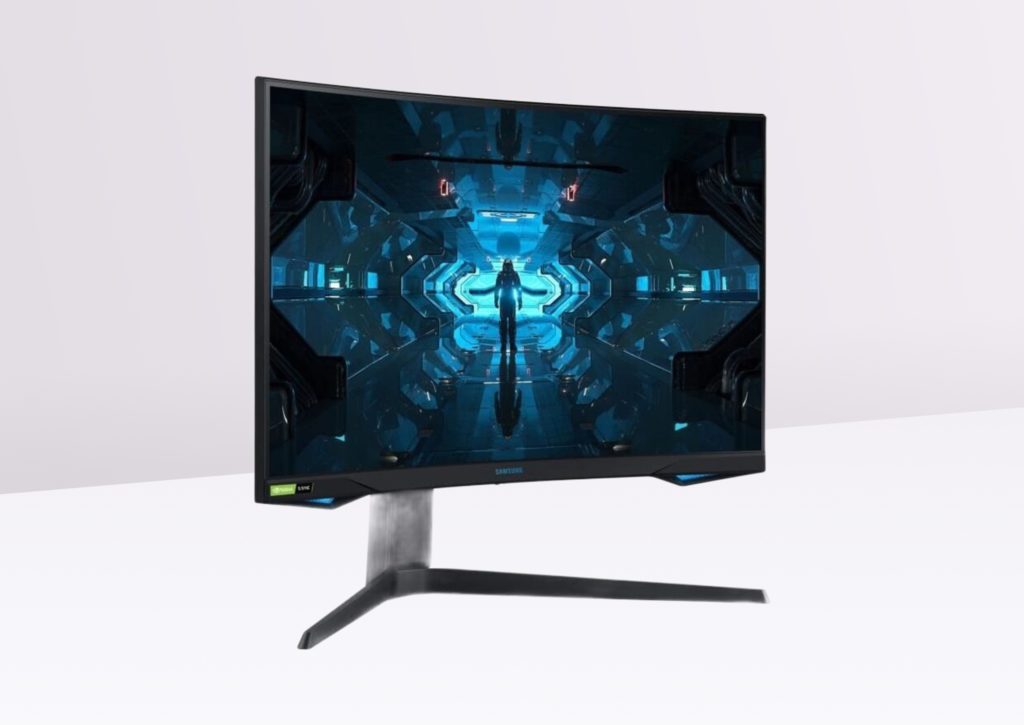
Advantages :
- 240 Hz refresh rate
- Solid, high-quality support
- Low prices
Disadvantages :
- No
The Samsung Odyssey G7 Incurvé is, as far as I’m concerned, the best screen you can have in a single-monitor setup, even if the size is at the minimum of what I can tolerate, i.e. 32″.
The panel is QLED, with HDR 600 certification, which is excellent for sim-racing. But the difference with its cousin, the ULTRA WQHD 34″, is that the G7 has a refresh rate of 240 Hz, which is just enormous. On the other hand, to push 240 Hz, you need a very powerful platform – only a high-end PC with an RTX 3090, or even more in some cases, especially if you max out the resolution at 1440P.
Another positive point is that this display is compatible with AMD FreeSync premium, giving you a wide range of features, such as a response time of one millisecond. Well, honestly, you’re not really going to see any difference with this response time (1 ms), as it represents an asset in competitive games like CS: GO, and company. In sim-racing, it’s nice to have.
As for the G7‘s price, you’ll need to spend around €600 to get it. Admittedly, this is almost 2 times more expensive than Samsung’s ULTRA WQHD 34″ , but at the same time you get more performance. As I said before, the 34″ WQHD is mainly aimed at sim-raceurs with a limited budget in terms of peripherals, platform and monitor. The G7 is a range above, aimed at people who are prepared to put in the money to acquire an excellent sim-racing setup.
Ultra-wide curved screens
The Samsung ODYSSEY G9

Advantages :
- 240 Hz refresh rate
- HDR 1000
- NVIDIA G-SYNC and FreeSync
Disadvantages :
- Premium prices
- High weight
I’m starting this category with an excellent screen, the Samsung ODYSSEY G9. First of all, it’s 49” diagonal, which is just enormous, especially for a curved screen. This size does have its drawbacks, such as weight, but it does add a high level of immersion to sim-racing.
This display is designed with gaming in mind, with a response rate of 1 ms, a resolution of 5120 x 1440, a refresh rate of 240 Hz (depending on resolution) and a host of ports to run on any platform.
If you’re into sim-racing and content consumption (videos and the like), you’re sure to love this display’s HDR 1000. Thanks to this and the 10-bit QLED technology, you’ve got a superb slab that displays a huge number of colors, and crisp ones at that. Quite simply, it’s magnificent.
Let’s move on to the disadvantages. To start with, the price: at over €1,400, the Samsung ODYSSEY G9 isn’t for everyone. Not only do you need to be able to afford it, you also need the machine to run it. Also, at 49” in 32/9 format, the screen is heavy. On the scales, the Samsung ODYSSEY G9 weighs in at 15 kg, and you need a solid and above all large setup to use and enjoy it. Nevertheless, I like this monitor, which is still excellent.
ASUS ROG Strix XG49VQ

Advantages :
- 144 Hz refresh rate
- Solid support
- Excellent viewing angles
Disadvantages :
- A little expensive
- Low HDR
In recent years, Asus has begun to diversify its product portfolio. In addition to motherboards and graphics cards, the manufacturer offers a whole range of top-quality gaming peripherals, such as the ROG Strix XG49VQ.
This monitor is a 49″, just like the Samsung G9, with an excellent viewing angle. However, where the Asus screen is not like the Samsung is its refresh rate of 144 Hz instead of 240, its resolution of 3840 × 1080 instead of 5120 x 1440 and its response time of 4 ms instead of 1 ms. I wonder if Samsung isn’t more geared to gaming…
In terms of on-board technologies, the ROG Strix XG49VQ features FreeSync 2, HDR 400, which is rather weak for its price, and Shadow Boost, an in-house technology that enhances certain details in dark areas of the screen.
Even if the design of this screen is brilliant, especially its stand which is superbly beautiful, this monitor pales in comparison with the competition, unless you can find it on special offer in the €600 or €800 range. If that’s the case, I’m in.
Multiple screens
Acer Nitro XV272U
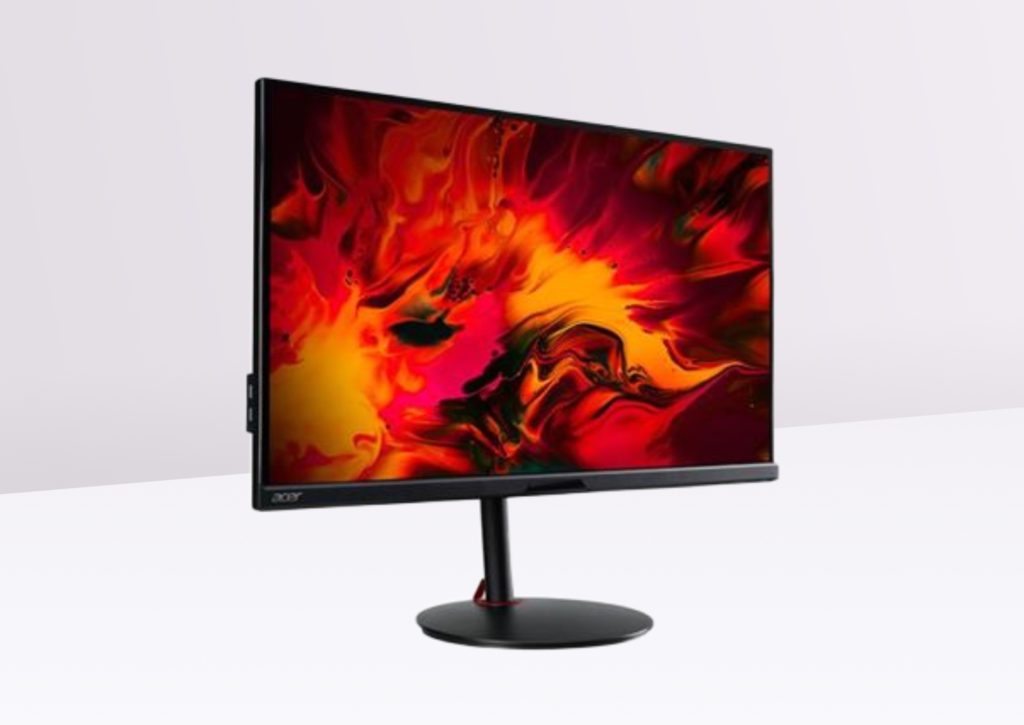
Advantages :
- 1440P
- 144 Hz refresh rate
- 1 ms response time
Disadvantages :
- Hardly any
As far as multi-screen setups are concerned, I’m going to introduce you to the Acer Nitro XV272U. It’s a 27″, FHD, 144 Hz panel with a response time of 1 ms. Classy, isn’t it?
This Acer is, I think, excellent for sim-racing because of its specs, but also because it has super-thin side borders, given that you’ll be using several of them for your setup. This is why I prefer a large screen of at least 34″ or an ultra-wide curved one, precisely to avoid dead zones around the edges.
The Acer is still an excellent product for sim-racing, thanks to its compatibility with G-Sync and FreeSync, its 1440P resolution and its 1 ms response time. Typically, this response time can be achieved on a smaller resolution (FHD) and at lower Hz. But that’s not the case with this screen, and that’s why I’ve put it on this list.
Price-wise, you’re looking at around €300 for this monitor. However, and this is where it hurts, you need to buy 2 or 3 for a good sim-racing setup. At that price, you might as well go for a big screen or ultra-wide curved if you ask me.
The Alienware AW2721D
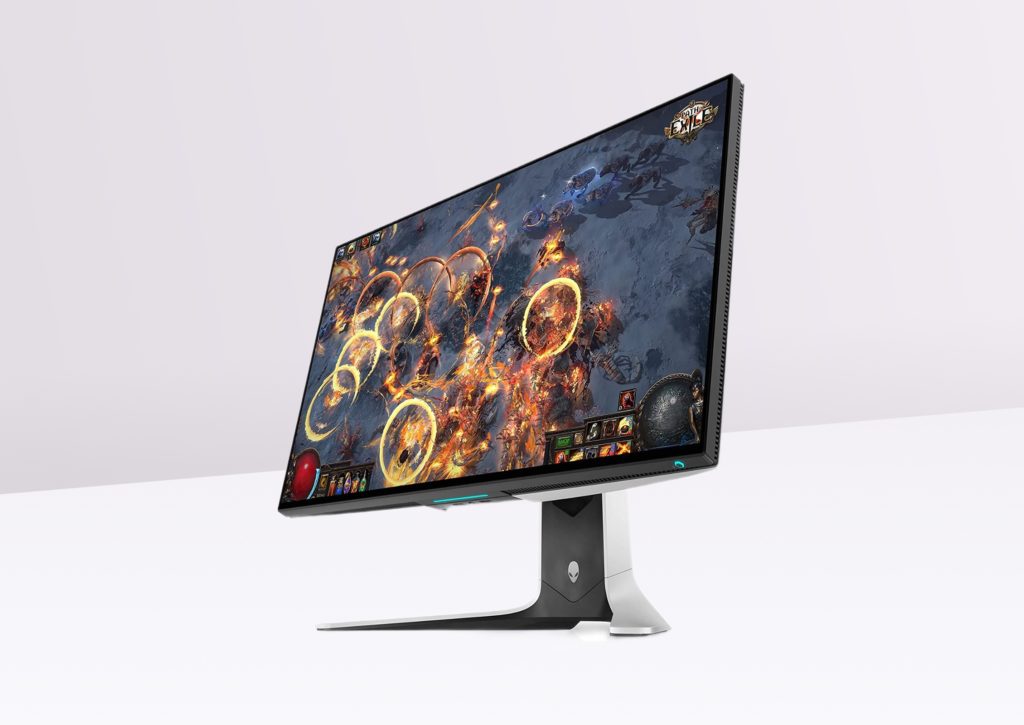
Advantages :
- 27” screen
- 240 Hz refresh rate
- G-Sync
Disadvantages :
- A premium price
Alienware has been an established brand in the gaming world for many years. In fact, when you think of “out of the box” gaming PCs, Alienware is the brand you immediately think of.
The screen I’m going to present to you now is the AW2721Dan excellent product for sim-racing if you put price aside. In my opinion, this is its only weak point. This monitor has a 27″ diagonal, making it ideal for a triple-screen setup. The edges are thin, reducing dead zones in front of you.
On the tech side, the AW2721D is Nvidia G-Sync compatible, has HDR 600, the panel is IPS and not VA like many other monitors, and with DisplayPort 1.4 and 2 HDMI 2.0. Its resolution is 2560 × 1440, with a refresh rate of 240 Hz and a response time of 1 ms. So far, so good as far as I’m concerned.
In use, even outside sim-racing, this screen is superb. Colors are vivid, contrast is a little short (1000:1) compared to Samsung monitors, for example, but it’ll do just fine.
I like the design. It’s quite sober, but you have to like the color. Sure, the edges are black, but the rest of the monitor is in a kind of light gray. But that’s not the most important thing.
I’ll briefly mention the support for this screen, and it’s great. You can adjust the monitor’s tilt and height. What’s really not great is its price. Listed at €770 on Amazon, it’s expensive for what you get, especially when a Samsung G7 is better in my opinion, for €100 less, and curved.
What type of screen to choose?
First and foremost, you need to decide what type of screen you want for your setup. Obviously, the choice of screen type takes into account budget, setup (cockpit or table), preferences and also the space you have available. Currently, sim-racing is done with 3 screen options, or types if you like: single screens, ultra-wide curved screens and multi-screen set-ups (usually 2 or 3).
- Simple screen. This option is relatively simple to set up and won’t take up much space in your setup, nor will it be super-expensive. However, having just one screen quickly shows its limitations, as the field of vision is reduced; you can only see what’s going on in front of you. Peripheral vision is almost non-existent.
- Ecran incurvé ultra-large. C’est devenu la mode depuis quelque temps de prendre un seul écran incurvé ultra-large pour une config sim-racing. Cette option est presque parfaite, car elle permet d’avoir un plus grand champ de vision que la config avec écran simple, et élimine les bordures qu’on a avec plusieurs écrans (on y revient juste après). Cependant, on peut noter comme inconvénients :
- Le prix : ces écrans sont chers, voire très chers.
- L’espace : les écrans incurvés sont très grands.
- Performance: curved screens make enormous demands on the platform due to the resolution they use.
- Multiple screens. This is a very popular sim-racing setup where you have 2 or 3 screens connected to your platform (typically PC). Each screen takes care of covering a field of view of the simu, giving you greater immersion. Obviously, if you put several screens next to each other, you’ll have dead zones in the middle where the borders are, even if they’re only 1 mm wide.
Then, as with any other sim-racing peripheral, the choice of screen depends on the needs of the sim-racer. If your setup can accommodate an ultra-wide curved screen and you can afford it, and above all the desire to invest time and money in this discipline, why deprive yourself?
Otherwise, I see 4 points to clarify before taking the plunge and buying a screen for sim-racing.
- Budget. It’s imperative to always shop within your budget, and the same goes for sim-racing displays. Even if the monitor is what allows you to see the race, don’t forget that you must have a steering wheel and pedals at least to accentuate immersion, and if you blow your entire budget on vision, you’ll be forced to race with a joystick.
- Screen size. The bigger, the better. For 1-screen setups, you should aim for 32 or 34” at least, and not exceed 49” in curved configuration if possible. However, for 3-screen setups, avoid exceeding 27″. However, don’t exceed certain sizes, at the risk of having a negative impact on your setup. As far as I’m concerned, I find that a 32-34″ curved panel is more than sufficient for almost all sim-racing setups.
- Refresh rate. It’s simple: this parameter goes hand in hand with the platform you have. The best is to have a 144 Hz or higher monitor, but this rate is difficult to achieve on some machines, especially consoles. So, as I say to anyone looking for a monitor: shop according to your machine. For example, if you’re on a console, which is perfectly fine for beginners, it’s best to get a 120 Hz screen. It’ll work perfectly for your current console, and you’ll have some margin for later. Don’t go for a 240 Hz screen when this refresh rate is unattainable on consoles, even in FHD.
- Dimensions. Always consider the dimensions available in your setup when buying the right screen size. The bigger the diagonal, the bigger the monitor. Check dimensions such as height, width and depth, not forgetting weight. On a cockpit, there are weight limits for monitors, just as there are on a table.
Conclusion
The screen is often a neglected point for sim-racing beginners, because they tell themselves that they already have a screen (often the simplest computer screen) and that it’s better to invest in a steering wheel or pedalboard. But choosing the right screen will greatly influence your sim-racing experience, and forever. The choice is vast on the market, as it is for any other peripheral.
If you’re looking for your first screen for a sim-racing setup, I suggest you try curved monitors. There’s no need to go ultra-wide like the Samsung G9, but a G7 at 32″ is excellent. It’s a great screen for the price, and it’ll give you great gaming experiences and even greater immersion.

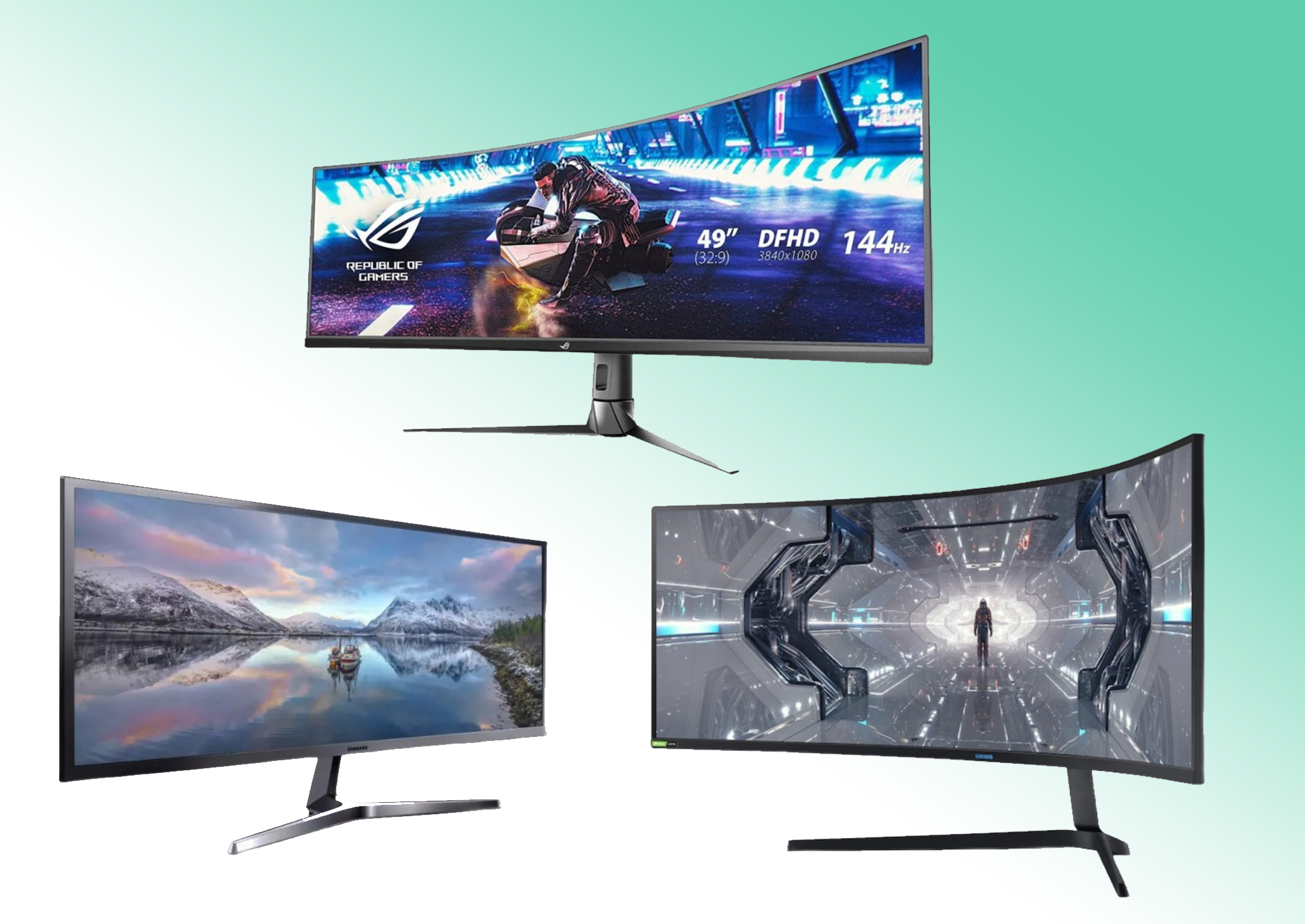

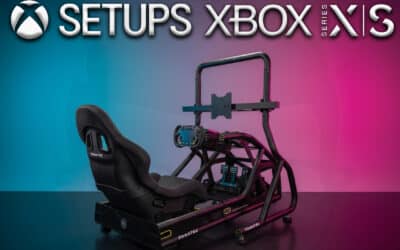

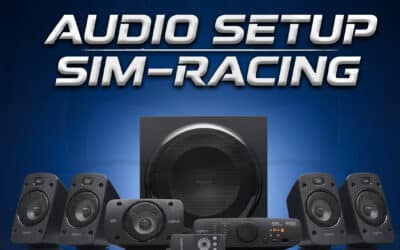

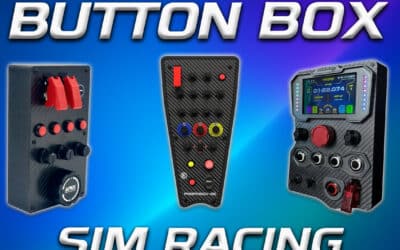
0 Comments